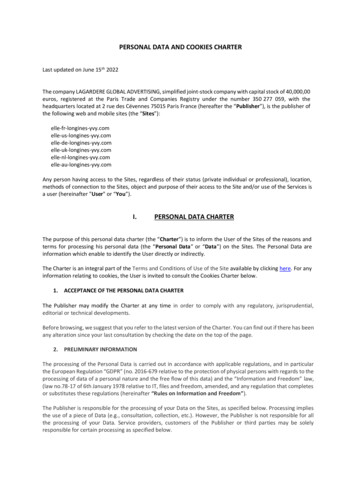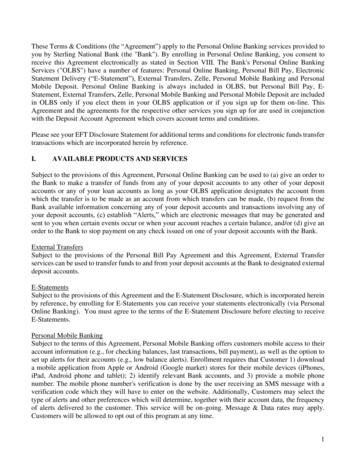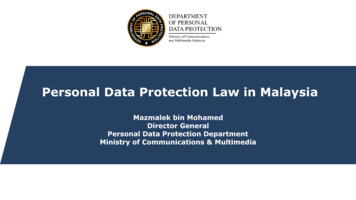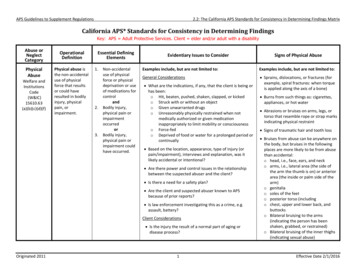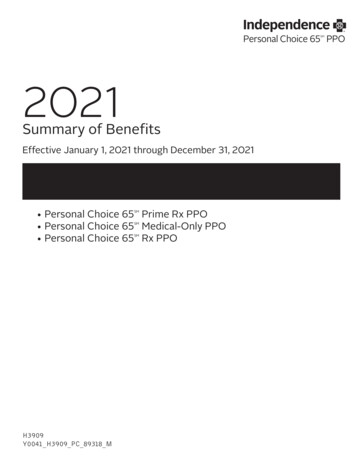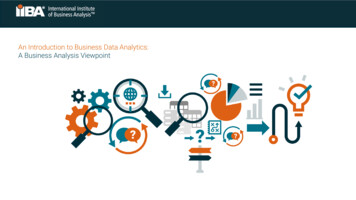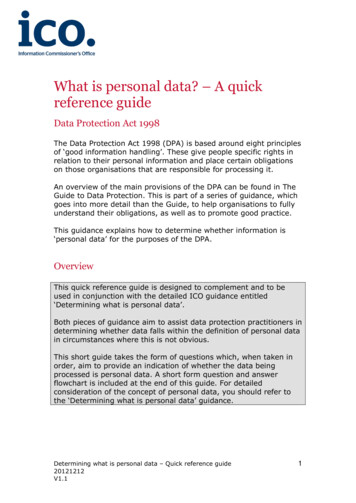
Transcription
What is personal data? – A quickreference guideData Protection Act 1998The Data Protection Act 1998 (DPA) is based around eight principlesof ‘good information handling’. These give people specific rights inrelation to their personal information and place certain obligationson those organisations that are responsible for processing it.An overview of the main provisions of the DPA can be found in TheGuide to Data Protection. This is part of a series of guidance, whichgoes into more detail than the Guide, to help organisations to fullyunderstand their obligations, as well as to promote good practice.This guidance explains how to determine whether information is‘personal data’ for the purposes of the DPA.OverviewThis quick reference guide is designed to complement and to beused in conjunction with the detailed ICO guidance entitled‘Determining what is personal data’.Both pieces of guidance aim to assist data protection practitioners indetermining whether data falls within the definition of personal datain circumstances where this is not obvious.This short guide takes the form of questions which, when taken inorder, aim to provide an indication of whether the data beingprocessed is personal data. A short form question and answerflowchart is included at the end of this guide. For detailedconsideration of the concept of personal data, you should refer tothe ‘Determining what is personal data’ guidance.Determining what is personal data – Quick reference guide20121212V1.11
IntroductionIf you hold information about individuals either on computer or incertain types of filing system you may be holding ‘personal data’.Broadly speaking the DPA covers four types of information (referredto as ‘data’ in the Act):(i)information processed, or intended to be processed,wholly or partly by automatic means (that is,information in electronic form usually on computer)1;(ii)information processed in a non-automated mannerwhich forms part of, or is intended to form part of, a‘filing system’ (that is usually paper records in a filingsystem)2(iii)information that forms part of an ‘accessible record’(that is, certain health records, educational records andcertain local authority housing or social servicesrecords, regardless of whether the information isprocessed automatically or is held in a relevant filingsystem)3; and(iv)information held by a public authority (referred to as‘category ‘e’ data’ as it falls within paragraph (e) ofsection 1(1) of the DPA).Not all information held in filing systems is covered by the DPA andthe Information Commissioner has also produced guidance to helpyou decide whether filed information falls within the scope of theAct: What is ‘data’ for the purposes of the DPAIn most circumstances it will be fairly easy to decide whether theinformation you hold falls within one of the four types of informationcovered by the DPA and whether the information ‘relates to’ an‘identifiable individual’ and is therefore ‘personal data’ regulated bythe Act.Where you are unsure, this quick reference guide comprises a seriesof questions which, when worked through in order, are intended tohelp you determine whether you hold personal data.1Data in electronic form is defined in section 1(1)(a) of the DPA.‘Relevant filing system’ is defined in section 1(1)(a) DPA.3‘Accessible record’ is defined in section 1(1)(d) and section 68 DPA.Determining what is personal data – Quick reference guide20121212V1.122
Is the information you hold ‘personal data’ for thepurposes of the Data Protection Act?There are several steps to determining whether the data you hold(electronic or manual) is ‘personal data’4 for the purposes of theDPA. Questions taking you through these steps are set out below5.1.Can a living individual be identified from the data, or,from the data and other information in yourpossession, or likely to come into your possession?YesGo to question 2.NoThe data is not personal data for the purposes ofthe DPA.Idenitfiability - An individual is 'identified' if you have distinguishedthat individual from other members of a group. In most cases anindividual’s name together with some other information will besufficient to identify them. Simply because you do not know thename of an individual does not mean you cannot identify thatindividual. The starting point might be to look at what means areavailable to identify an individual and the extent to which suchmeans are readily available to you.2.Does the data ‘relate to’ the identifiable livingindividual, whether in personal or family life,business or profession?YesThe data is ‘personal data’ for the purposes of theDPA.NoThe data is not ‘personal data’ for the purposes ofthe DPA.Unsure See questions 3 to 8 below.Meaning of ‘relates to’ - Data which identifies an individual, evenwithout a name associated with it, may be personal data where it isprocessed to learn or record something about that individual, orwhere the processing of that information has an impact upon thatindividual. Therefore, data may ‘relate to’ an individual in severaldifferent ways, the most common of which are considered below.45See definition of ‘personal data’ section 1(1) DPA.See also p. 5-7 Legal GuidanceDetermining what is personal data – Quick reference guide20121212V1.13
3.Is the data ‘obviously about’ a particular individual?YesThe data is ‘personal data’ for the purposes of theDPA.NoGo to question 4.Data ‘obviously about’ an individual will include his medical history,criminal record, record of his work or his achievements in a sportingactivity.Data that is not ‘obviously about’ a particular individual may includeinformation about his activities. Data such as personal bankstatements or itemised telephone bills will be personal data aboutthe individual operating the account or contracting for telephoneservices.Where data is not ‘obviously about’ an identifiable individual it maybe helpful to consider whether the data is being processed, or couldeasily be processed, to learn, record or decide something about anidentifiable individual. Information may be personal data where theaim, or an incidental consequence, of the processing, is that youlearn or record something about an identifiable individual, or theprocessing could have an impact on, or affect, an identifiableindividual.4.Is the data ‘linked to’ an individual so that itprovides particular information about thatindividual?YesThe data is ‘personal data’ for the purposes of theDPA.NoGo to question 5.ExampleThere is a single named individual employed in a particular post,the salary information about the post will be personal data‘relating to’ the single employee occupying that position.5.Is the data used, or is it to be used, to inform orinfluence actions or decisions affecting anidentifiable individual?YesThe data is ‘personal data’ for the purposes of theDPA.Determining what is personal data – Quick reference guide20121212V1.14
NoGo to question 6.Informing or influencing decisions - Example: Data about anindividual’s phone or electricity account clearly determines what theindividual will be charged.Different organisations may process the same data for differentpurposes.A single piece of data, which is not personal data when processedby one person may become personal data when it is processed byanother person depending on the purpose of the processing and thepotential impact of the processing on individuals.6.Does the data have any biographical significance inrelation to the individual?YesThe data is likely to be personal data for thepurposes of the DPA.NoGo to question 7.UnsureGo to question 7.Biographical significance - When considering ‘biographicalsignificance’, what is important is whether the data goes beyondrecording the individual’s casual connection with a matter or eventwhich has no personal connotations for him.The fact that an individual attended the meeting will be personaldata about that person. However, this does not mean thateverything in the minutes of that meeting is personal data abouteach of the attendees.7.Does the data focus or concentrate on the individual asits central theme rather than on some other person, orsome object, transaction or event?YesThe data are likely to be personal data for thepurposes of the DPA.NoGo to question 8.UnsureGo to question 8.When considering the 'focus' of information it may be helpful toconsider whether the information is being processed to recordDetermining what is personal data – Quick reference guide20121212V1.15
something about an individual or to record information about anobject.Whether information is linked to an individual, for example, to learnsomething about that individual, is the key factor in determiningwhether information about an object is personal data.Example: information as to the number of products produced by amachine in a week could be used, either to access the efficiency ofthe machine, or it could be used to access the productivity of theindividual operating the machine.8.Does the data impact or have the potential to impact onan individual, whether in a personal, family, business orprofessional capacity?YesThe data is ‘personal data’ for the purposes of theDPA.NoThe data is unlikely to be ‘personal data’.Even though the data is not usually processed by the data controllerto provide information about an individual, if there is a reasonablechance that the data will be processed for that purpose, the datawill be personal data.If you are still unsure whether the information you hold ispersonal data for the purposes of the DPA see the detailedICO guidance “Determining what is personal data” and“Determining what is data”.A flowchart of the above questions is set out below.Determining what is personal data – Quick reference guide20121212V1.16
Flowchart1.2.Can a living individual be identified from the data, or,from the data and other information your possession,or likely to come into your possession?YesGo to question 2.NoThe data is not personal data for the purposes of theDPA.Does the data ‘relate to’ the identifiable livingindividual, whether in personal or family life, businessor profession?YesThe data is ‘personal data’ for the purposes of theDPA.NoThe data is not ‘personal data’ for the purposes of theDPA.Unsure See questions 3 to 8 below.3.4.Is the data ‘obviously about’ a particular individual?YesThe data is ‘personal data’ for the purposes of theDPA.NoGo to question 4.Is the data ‘linked to’ an individual so that it providesparticular information about that individual?YesThe data is ‘personal data’ for the purposes of theDPA.NoGo to question 5.Determining what is personal data – Quick reference guide20121212V1.17
5.6.7.8.Is the data used, or is it to be used, to inform orinfluence actions or decisions affecting an identifiableindividual?YesThe data is ‘personal data’ for the purposes of theDPA.NoGo to question 6.Does the data have any biographical significance inrelation to the individual?YesThe data is likely to be personal data for thepurposes of the DPA.NoGo to question 7.UnsureGo to question 7.Does the data focus or concentrate on the individual asits central theme rather than on some other person, orsome object, transaction or event?YesThe data is likely to be personal data for thepurposes of the DPA.NoGo to question 8.UnsureGo to question 8.Does the data impact or have the potential to impact onan individual, whether in a personal, family, business orprofessional capacity?YesThe data is ‘personal data’ for the purposes of theDPA.NoThe data is unlikely to be ‘personal data’.Determining what is personal data – Quick reference guide20121212V1.18
No The data is not personal data for the purposes of the 2. Does the data 'relate to' the identifiable living individual, whether in personal or family life, business or profession? Yes The data is 'personal data' for the purposes of the DPA. No The data is not 'personal data' for the purposes of the DPA. Unsure See questions 3 to 8 .

